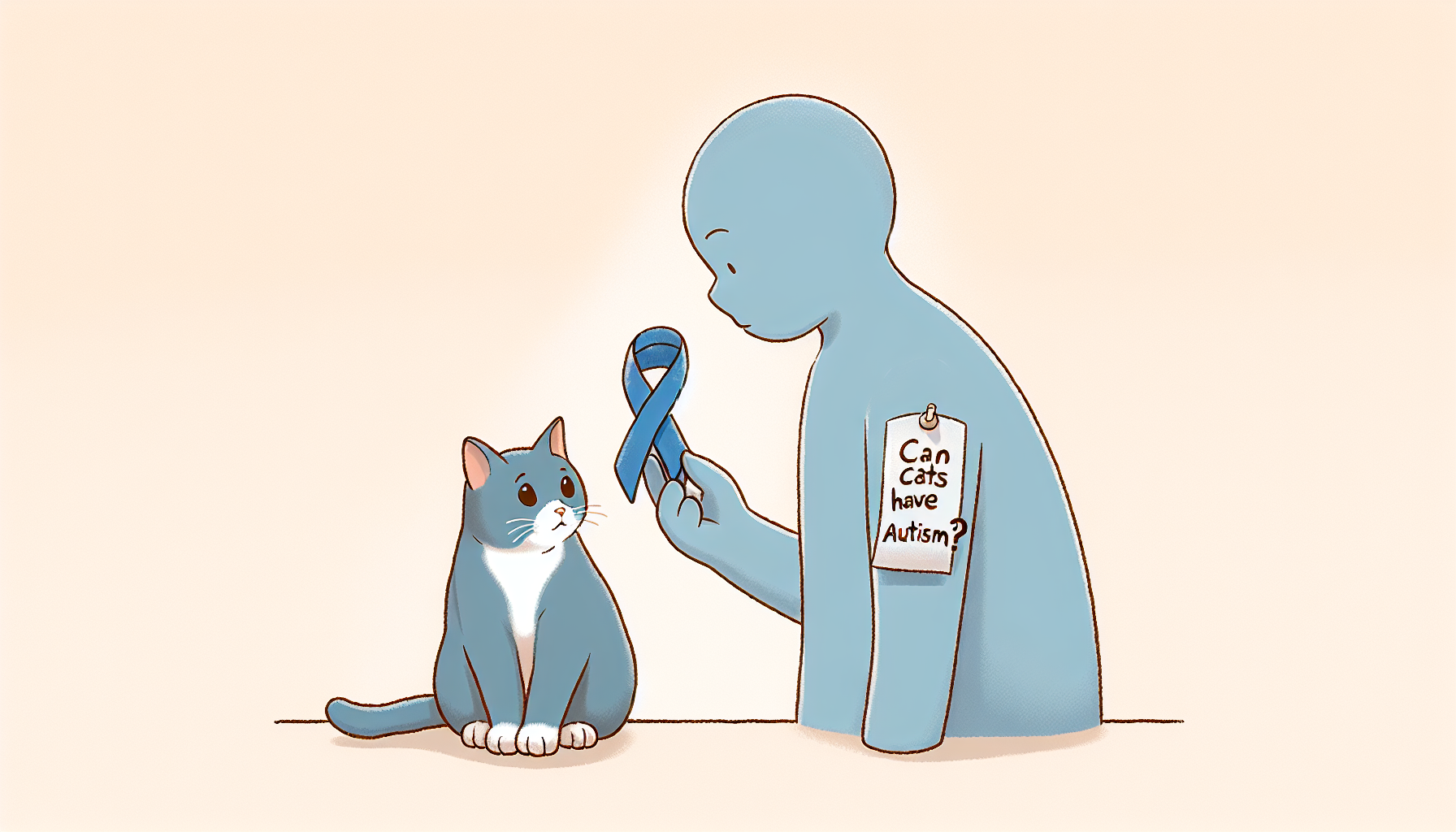Understanding Feline Behavior
To better understand the concept of cats potentially having autism, it is important to delve into feline behavior and the unique characteristics that make cats fascinating creatures.

Feline Neurodiversity
Cats and humans have distinct brain structures and social behaviors, making it challenging to draw direct comparisons between their experiences. While the existence of autism in cats is not scientifically proven or widely accepted, some cat owners and caregivers have reported observing behaviors in their cats that they associate with autistic traits, such as repetitive movements, avoidance of social interaction, sensitivity to certain stimuli, and difficulty adapting to change. However, it is important to note that these behaviors may have other explanations, such as feline neurodevelopmental disorders or environmental factors, and further research and scientific investigation are needed to understand and interpret these behaviors.
Unique Cat Behaviors
Cats possess a wide range of behaviors and personalities, which contribute to their unique charm and individuality. Some behaviors that may resemble autism traits in cats could be attributed to normal feline behavior rather than autism. Cats, like humans, exhibit a diverse array of behaviors and personalities. Each cat is an individual, and their behaviors can vary significantly from one feline to another [2]. It is important to remember that certain behaviors in cats may simply be a part of their individual personality or influenced by factors such as genetics, environment, or socialization [2].
While the debate about whether cats can have autism continues, it is crucial to approach the topic with an open mind and rely on scientific evidence to draw accurate conclusions. Understanding the complexities of feline behavior and acknowledging the individuality of cats is essential in order to avoid misinterpretation of their behaviors.
Exploring Cat Autism Debate
The question of whether cats can have autism is a topic of debate among experts in veterinary medicine and animal behavior. Currently, there is limited scientific evidence available to support the existence of autism in cats. It’s important to note that the concept of autism primarily focuses on Autism Spectrum Disorder (ASD) in humans and its diagnosis, treatment, risk factors, and occurrence among different demographic groups.
Lack of Scientific Evidence
There is currently no evidence or information available to suggest that cats can have autism. The study of autism in cats is still in its infancy, and researchers have not yet been able to establish a definitive link between autism and feline behavior. The brain structures and social behaviors of cats and humans are fundamentally different, making it challenging to directly compare their experiences.
Observations and Explanations
While some cat owners report observing behaviors in their cats that resemble autistic traits, it’s important to approach these observations with caution. These behaviors may have other explanations such as feline neurodevelopmental disorders or environmental factors. Cats have unique personalities and behaviors that may vary from one individual to another, making it difficult to draw a direct parallel to autism in humans. It’s essential to consider multiple factors and consult with veterinary professionals to properly understand and address any concerning behaviors in cats.
As the field of veterinary medicine and animal behavior continues to evolve, more research may shed light on the topic of autism in cats. However, at present, the scientific evidence remains limited, and the concept of autism primarily pertains to human neurodevelopmental disorders. It is crucial to focus on understanding and addressing the specific needs and behaviors of cats within the context of feline behavior and welfare.
Signs and Symptoms in Cats
While the concept of cats having autism is still a topic of debate among experts, some cat owners have reported observing behaviors in their cats that resemble autistic traits. However, it’s important to note that these behaviors may have other explanations, such as feline neurodevelopmental disorders or environmental factors. Further research and scientific investigation are needed to fully understand and interpret these behaviors.
Atypical Behaviors
Some cats may display atypical behaviors that could be mistaken for signs of autism. These behaviors might include:
- Repetitive movements: Cats may engage in repetitive behaviors such as pacing, spinning, or tail chasing. These actions can be a result of stress, anxiety, or other underlying factors.
- Avoidance of social interaction: Some cats may prefer solitude and show limited interest in social interactions. They might be less inclined to seek attention, play with other animals, or engage in typical cat-human interactions.
- Difficulty adapting to change: Cats with atypical behaviors may struggle with changes in their environment or routines. They might display signs of stress or anxiety when faced with unfamiliar situations or new stimuli.
It’s important to remember that these behaviors alone do not necessarily indicate autism. They can be influenced by various factors, including genetics, environment, or socialization. When observing atypical behaviors in cats, it’s crucial to consider other potential explanations, such as feline neurodevelopmental disorders or underlying medical conditions.
Sensitivity to Stimuli
Some cat owners have reported that their cats exhibit sensitivity to certain stimuli, which they associate with autistic traits. These sensitivities might include:
- Sensitivity to touch: Cats with atypical behaviors may be more sensitive to being touched or petted. They might show signs of discomfort or become easily overstimulated during physical contact.
- Sensitivity to sounds: Cats might display heightened reactions to certain sounds, such as loud noises or high-pitched tones. These sensitivities can manifest as fear or anxiety responses.
- Sensitivity to environmental changes: Cats with atypical behaviors may have difficulty adapting to changes in their environment. They might show signs of stress or exhibit avoidance behaviors when faced with alterations in their surroundings.
It’s essential to approach these sensitivities with caution and provide a calming and predictable environment for your cat. Consultation with a veterinarian or a certified animal behaviorist can help assess your cat’s behaviors more accurately and determine the best course of action to support their well-being [1].
Diagnosing Feline Autism
When it comes to diagnosing feline autism, there are several challenges that arise due to the lack of a standardized diagnostic framework for animals [2]. Unlike humans, there is no formal diagnosis of autism for cats, and the concept of autism in cats is still a topic of debate among experts in the field of veterinary medicine and animal behavior [1].
Challenges in Diagnosis
The primary challenge in diagnosing feline autism is the absence of established diagnostic criteria specifically tailored for cats. The diagnostic criteria and understanding of autism are primarily based on human observations and research. Applying the same criteria to cats may not be accurate or appropriate [1].
Furthermore, cats exhibit a wide range of behaviors that can be considered atypical. These behaviors may be influenced by various factors, including feline neurodevelopmental disorders, environmental factors, and underlying medical conditions. It is crucial to consider these factors when observing atypical behaviors in cats, as they may have alternative explanations apart from autism.
Seeking Professional Guidance
If you suspect that your cat may have autism or if you’re concerned about their behavior, it is essential to seek professional advice. Consulting with a veterinarian or an animal behaviorist who specializes in feline behavior can provide valuable insights and guidance [2]. These professionals have the expertise to assess your cat’s behavior and determine if there are any underlying issues or conditions that may require attention.
During the evaluation process, the veterinarian or animal behaviorist will consider various factors, including your cat’s medical history, behavior patterns, and environmental factors. They may conduct thorough observations and assessments to gain a comprehensive understanding of your cat’s behavior. Based on their expertise and experience, they will provide you with a professional evaluation and guidance on the best course of action for your cat’s specific needs.
While a formal diagnosis of autism may not be possible for cats at this time, seeking professional guidance is still crucial in understanding and addressing your cat’s behavior. With the right care and treatment, cats with atypical behaviors, including those exhibiting characteristics similar to autism, can lead happy and fulfilled lives. By working closely with professionals, you can develop a tailored treatment plan that focuses on your cat’s well-being and overall quality of life.
Treatment and Care
When it comes to the treatment and care of cats with autism, there are strategies that can help improve their well-being and quality of life. These include behavior modification techniques and creating a calming environment.
Behavior Modification Techniques
Behavior modification techniques can be effective in helping cats with autism manage their atypical behaviors and develop more appropriate responses to stimuli. These techniques involve positive reinforcement and reward-based training to encourage desirable behaviors and discourage unwanted ones.
For example, if a cat exhibits excessive scratching or aggressive behaviors, redirecting their attention to a designated scratching post or providing interactive toys can help redirect their behavior. Consistency and patience are key when implementing behavior modification techniques as it can take time for cats to adapt and respond to the training.
Creating a Calming Environment
Creating a calming environment is crucial for cats with autism. A predictable and low-stress environment can help reduce anxiety levels and provide them with a sense of security. Here are some strategies to consider:
- Establish a regular routine: Cats with autism thrive on consistency and predictability. Maintaining a regular feeding schedule, playtime, and providing a designated quiet space for rest can help create a sense of stability.
- Provide enrichment toys: Enrichment toys, such as puzzle feeders and interactive toys, can help stimulate the cat’s mind and provide a positive outlet for their energy. These toys can help alleviate boredom and reduce the likelihood of engaging in destructive behaviors.
- Offer hiding places: Cats with autism may feel overwhelmed by loud noises or excessive stimuli. Providing hiding places, such as cat condos or enclosed beds, allows them to retreat to a safe and quiet space when they need to.
- Use pheromone therapy: Pheromone therapy, such as synthetic feline facial pheromones, can help create a calming effect and reduce stress in cats. These pheromones mimic natural chemical signals that cats use to communicate and feel secure in their environment.
- Minimize exposure to triggers: Identify and minimize exposure to triggers that may cause anxiety or overstimulation in your cat. This can include loud noises, unfamiliar people, or certain scents. By reducing exposure to these triggers, you can help create a more relaxed environment for your feline friend.
By implementing behavior modification techniques and creating a calming environment, you can support the well-being and happiness of cats with autism. It’s important to seek professional guidance from a veterinarian or animal behaviorist to develop an individualized treatment plan that addresses the specific needs of your cat. With the right care and support, cats with autism can lead fulfilling lives.
Supporting Cats with Autism
Cats with autism, just like any other cats, require special care and attention to ensure their well-being and happiness. While there is ongoing debate surrounding the existence of feline autism, it is important to address the unique needs of cats that exhibit atypical behaviors. Here are some strategies to support cats with potential autism-like behaviors:
Enrichment Strategies
Enrichment is crucial for cats with autism to provide mental stimulation, reduce anxiety, and promote overall well-being. Consider the following enrichment strategies:
- Provide plenty of toys: Offer a variety of toys that stimulate different senses, such as interactive toys, puzzle toys, and toys with textures. These toys can engage the cats and keep them mentally stimulated.
- Create vertical space: Cats with autism may benefit from having perches or cat trees where they can climb, observe their surroundings, and retreat to a safe space. Vertical space provides a sense of security and allows them to fulfill their natural instincts.
- Offer scratching posts: Scratching is a natural behavior for cats and can help them relieve stress and mark territory. Provide sturdy scratching posts or boards to redirect their scratching behavior away from furniture.
- Provide hiding spots: Cats with autism may be sensitive to stimuli and may require a safe place to retreat when feeling overwhelmed. Provide hiding spots such as enclosed beds or hiding boxes where they can seek solace and feel secure.
Ensuring Well-Being
Maintaining the well-being of cats with potential autism-like behaviors involves creating a calming environment and addressing any underlying medical conditions. Consider the following strategies:
- Establish a routine: Cats with autism thrive in predictable environments. Establish a consistent daily routine for feeding, playtime, and rest. Consistency can help reduce anxiety and provide a sense of security.
- Reduce exposure to triggers: Identify any stimuli that may cause distress or anxiety for your cat. These triggers can include loud noises, sudden movements, or unfamiliar people. Minimize their exposure to these triggers to create a more soothing environment.
- Seek professional guidance: If you suspect your cat may have autism-like behaviors, consult a veterinarian who specializes in feline behavior. They can provide a thorough evaluation and help create an appropriate treatment plan tailored to your cat’s specific needs.
- Consider behavior modification techniques: Positive reinforcement training techniques can be beneficial for modifying unwanted behaviors and promoting positive behaviors. Reward desired behaviors with treats or praise to encourage your cat’s engagement.
With the right care and treatment, cats with potential autism-like behaviors can lead happy and fulfilled lives. It is essential to seek professional guidance from a veterinarian to develop an appropriate treatment plan based on your cat’s individual needs. By providing a calming environment, enrichment opportunities, and addressing any underlying medical conditions, you can support your cat’s overall well-being and provide them with a loving and nurturing home environment.

 We've just released an article!
Check out our blog!
We've just released an article!
Check out our blog!



